Bringing dark life to light
The stunning realization that up to half of life on Earth may exist underground has transformed biologists thinking about the origin and evolution of life here and on other planets. The search for "dark life" could go to new depths at a proposed underground laboratory.
By Kathryn Grim
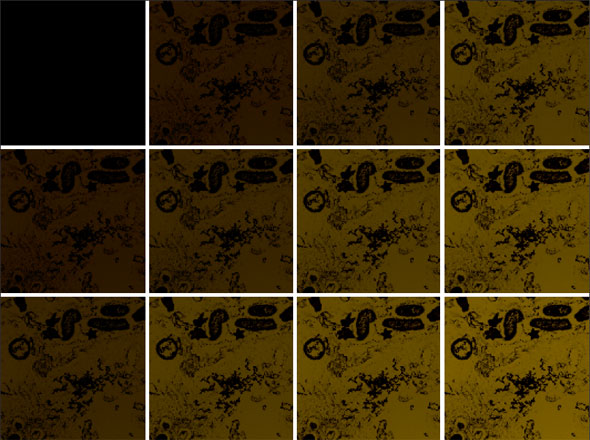 |
In 1988, a team of Swedish scientists drilled 1000 meters into the ground to gather rock and groundwater samples for a study aimed at improving the disposal of nuclear waste. They were looking for microorganisms that might interact with buried waste canisters, and they expected to find only a few.
Instead the scientists stumbled upon an entire ecosystem of undiscovered microbes, flourishing beneath their feet.
Scientists had imagined that life could exist underground, but what startled microbiologist Karsten Pedersen were the number, variety, and liveliness of organisms living so deep underground that they were cut off from anything touched by the sun. "They were active; they were happy," he says. "We didnt understand how, since they were so isolated."
Microbe hunting has been around for centuries. In the 1670s, Dutch microscope hobbyist Antonie van Leeuwenhoek first discovered bacteria and swimming protozoa, which he described as "animalcules" and "wretched beasties." But until the 1980s, scientists literally had only scratched the surface of the world of these invisible creatures. Scientists have since found signs of life down as deep as they have looked, about four kilometers beneath the surface. Through their studies they have pioneered a new field of research: geomicrobiology. Now some biologists estimate that there may be just as much "dark life" beneath the surface of the Earth as there is sun-based life above it.
Pedersen calls the microbes his team found "the toughest organisms on the planet." They live anywhere with liquid water, which can be "as acidic as vinegar more alkaline than washing powder, boiling hot, or freezing cold as the Antarctic," he wrote for a museum exhibition in Sweden.
Biologists postulate that many of the microorganisms living deep beneath the Earths crust are much older than any human alive. Based on the rate at which they feed, these tiny creatures appear to mature slowly over the course of a thousand years. They live on compounds such as sulfides, iron oxide, carbon dioxide, and ammonium, and even elements like uranium, hydrogen, or arsenicnot something most of us would like to find in our breakfast cereal. If they find themselves without food, they can sleep as soundly as Rip Van Winkle for years at a time until nourishment returns.
Scientists hope studies in geomicrobiology could lead to the development of new drugs and biofuels and improved methods of sequestering carbon dioxide and purifying contaminated groundwater. The field also has the potential to revolutionize the search for life on other planets, as well as offer clues to the origin and evolution of life on Earth.
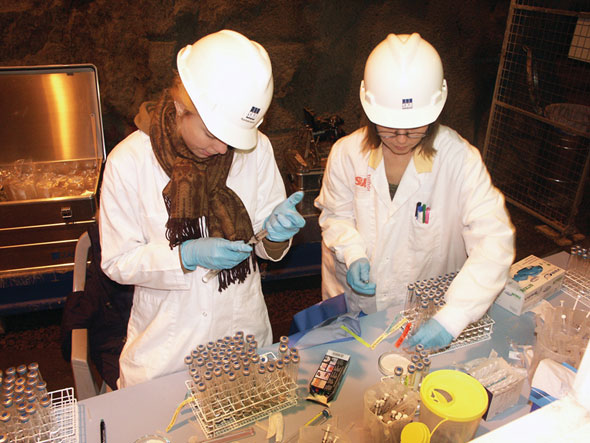 |
| Scientists Anna Hallbeck (left) and Jessica Johansson work 450 meters underground in the Äspö Hard Rock Laboratory. During expeditions, scientists sometimes work in the tunnel if there is not enough room inside the laboratory container. Image courtesy of Karsten Pedersen, University of Gothenburg, Sweden |
Yet most geomicrobiological studies to date have taken place in less than ideal circumstances, piggybacking on mining or oil drilling operations or radioactive-waste disposal programs. These types of arrangements allow scientists only limited access to their subjects and introduce the threat of contamination.
Soon, though, some biologists hope to have a space of their own in one of the deepest underground laboratories in the world. The Deep Underground Science and Engineering Laboratory, proposed for a former gold mine in Homestake, South Dakota, would include space for biologists along with nuclear and particle physicists, geologists, hydrologists, geoengineers, and biochemists.
The main driver behind the proposed lab is particle astrophysics, which needs quiet, sheltered spaces to search for dark matter and study rarely interacting subatomic particles like neutrinos. But seven of the initial 16 research proposals being developed with funding from the National Science Foundation are for studies in other fields, including biology.
From their base in the labs lowest level, more than 2000 meters underground, biologists would drill even farther into the Earth. Having a dedicated space would allow them to develop long-term studies of the slow-moving, long-living microbes below.
 |
| Scientists found these bacteria 112 meters below ground in the Äspö Hard Rock Laboratory. They belong to the genus Desulfovibrio. These bacteria use sulfate as an oxidizing agent, reducing it to sulfide. This can threaten underground construction and radioactive waste canisters, as sulfide is corrosive to metals Image courtesy of Karsten Pedersen, University of Gothenburg, Sweden |
So many microbes, so difficult to reach
Like their counterparts above ground, dark microbes can be difficult to cultivate in a lab; 99 percent cannot grow in a Petri dish. Many would still be invisible to science if not for techniques that allow researchers to probe the environment for bits of genetic material and use it to identify microbial species.
Scientists have just begun to sequence the genetic codes of the microorganisms they are discovering underground. Already they have recorded in an international database the RNA gene codes of more than one million microbes, only a quarter of which scientists have grown in the laboratory. The number of species of microorganisms scientists continue to find has not even begun to plateau, says Jim Tiedje, distinguished professor of microbial ecology at Michigan State University.
"Were always coming up with new ones," he says. "Naming them is a problem right now; we just use letters and numbers."
Biologists have many unanswered questions about these organisms: How long have they been there? How far can they travel? How long do they live? How do they affect their environments? Are their populations controlled by the availability of food, or the prevalence of bacteria-infecting viruses or predators?
These questions can be difficult to answer, under the circumstances. The dearth of locations in which to conduct long-term studies keeps the number of scientists studying the deep biosphere low, says biologist T.C. Onstott of Princeton University. He estimates that the entire field comprises only about 300 scientists, most of whom study life below the seafloor with the help of international drilling ships.
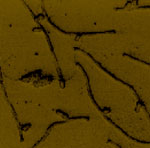 |
| These long, slender cells belong to the genus Bacillus. The two single-celled microbes with flagella, which resemble tails, have followed groundwater from a fault system at the surface down to a borehole 68 meters underground in the Äspö Hard Rock Laboratory Image courtesy of Karsten Pedersen, University of Gothenburg, Sweden |
Nature show
One of the few spaces in the world dedicated to long-term studies in geomicrobiology is located in Äspö, Sweden. Today Pedersen works there in a laboratory that resembles a large shipping container more than 450 meters underground in a mine operated by the Swedish Nuclear Fuel and Waste Management Company.
The laboratory is accessible by elevator or by car; "My cave is paved," Pedersen says. It also comes equipped with a climate-control system, a coffee machine, a refrigerator, and phone and Internet connections. But most importantly, it allows Pedersen to observe microscopic life in the wild.
Sometimes, Pedersen and his small team collect samples and data to bring back to their laboratories on the surface. They don hard hats, boots, and reflective gear; pack a carful of bottles, tubes, filters, and electrodes; and set off into the cavern in search of habitable cracks in the rock. They collect samples for cultivation and analysis and measure important aspects of the microbes environment, including its pH, conductivity, and ability to support respiration.
But just as an animals behavior in a zoo does not exactly mimic its behavior in nature, microbes do not act the same way in a Petri dish as they would in their home environment, be it a cave, the bottom of the ocean, or inside an intestinal tract. And as one travels deeper underground, "the pressure of the groundwater increases, just like when you dive in the sea," Pedersen says. "Being in the tunnel underground is almost like being in a submarine." Bringing organisms used to this pressure to the surface would change them, if not destroy them.
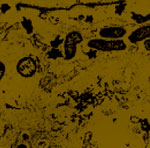 |
| Microbial biofilma community of microbes encased in protective slimefrom 2 km deep in a South African platinum mine. It contains star-shaped bacteria that had never been seen before. Their habits and relationships to known organisms are under study. Image courtesty of Gordon Southam, The University of Western Ontario, Canada |
So Pedersen uses a series of tubes, each two millimeters in diameter, about 60 meters long, and "bloody expensive," to pipe the microbes and their environment into his underground lab. The tube starts at a colony of microbes living in a water-filled crack in the cave. The water and microbes are pumped through the tube and along a path into his shipping-container laboratory.
Pedersen and his team can guide microbes from the same population into multiple pipes, which they can manipulate in different ways and compare. "We can add food, take away food, see how different compounds affect the systems," Pedersen says. "We can test our ideas, so its more like classical lab work. No one else is doing these types of studies."
On borrowed time
However, most biologists studying deep life must make do without a dedicated underground space.
Like many in the field, Onstott studies microbes in a working mine, visiting South Africa about once a year for a few long days of field research.
"Many mines in the US are frankly not deep enough for my interests," he says. "I go to South Africa because the mines are so deep that you get into temperatures of up to 70 degrees Centigrade. Thats good for us. We like nice, hot organisms."
On a typical day of prospecting, he enters the Tau Tona Au mine with the miners at 7 a.m. They take the first cage elevator, which drops down the shaft at about 30 to 40 kilometers per hour. At the bottom of that shaft, they exit and enter another. It drops and then they enter a third cage. After that, they start to walk. They have travelled more than 3.7 kilometers underground.
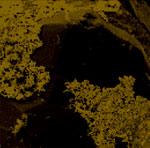 |
| Microbial biofilm on gold crystals found in rocks collected from a South African mine. Researchers are trying to determine whether bacteria, rather than toxic chemicals, can be used to remove dissolved gold from mine waters. Image courtesty of Gordon Southam, The University of Western Ontario, Canada |
"It takes about two hours to finally get to your spot," Onstott says. "You spend about an hour there, then start getting your way back to the cage."
In this situation, the minersand their profitable businesscome first.
"If we say we need 12 people to set up an experiment and weve got about 500 pounds of gear, we might get on the schedule six months from now," Onstott says. "If we need to drill, we need to arrange with a contractor and can only drill after they finish. Its just a long, slow, tedious process."
Adding to the frustration, a particular research area may be available for only a month before the miners tunnel right through it.
"On one trip, we found a star-shaped bacterium," Onstott says. "That was pretty neat. Weve been trying to figure out why the hell it would be shaped like that. But we havent been able to get back to the spot where we found it again.
The origins of life, here and elsewhere
Like Pedersen, Onstott stumbled upon geomicrobiology in the 1980s while investigating ways to better dispose of nuclear wastein his case, radioactive compounds left over from nuclear weapons manufacturing. He was responsible for ascertaining the origins of the microbial flora scientists found in a post-Cold War study by the Department of Energys environmental management office.
He was amazed at the organisms diversity and abundance. "Everyone thought that beneath the soil zone, life stopped," he says.
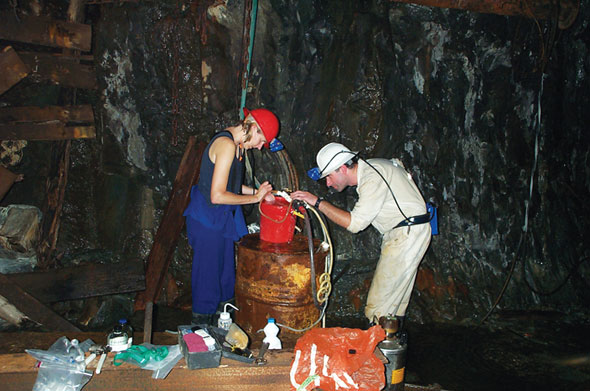 |
| Biologists filtering water samples from 2.7 km deep in a borehole in the Driefontein gold mine in South Africa. The borehole goes down 3.5 km and contains a novel heat-loving microorganism that had not been previously encountered. Photo courtesy of Duane Moser, Pacific Northwest National Laboratory |
When he travelled to Africa, Onstott discovered that some families of microorganisms had spread surprisingly far and wide. "I was finding that species of bacteria you can find deep in the subsurface of Africa are also present in the seafloortens of thousands of kilometers apart from one another, but the same species," he says. "But the surface of South Africa has not seen the ocean in two billion years."
These microorganisms appeared to have been isolated from the surface for millions or perhaps tens of millions of years, he says. "It begs the question: Where did they come from in the first place?"
Scientists initially speculated that life arose on the Earths surface, moved underground and survived there during an especially violent period when the young planet faced a bombardment of meteors, volcanic eruptions, and radiation from space.
However, many geomicrobiologists wonder if the origins of life can instead be traced to the shelter of the subterranean.
"What makes people think that life had to go underground?" Pedersen says. "Maybe the question is: When did life go to the surface? When was life strong enough to leave the safe and protective underground with no wind, solar radiation, or thunderstorms?"
These discoveries also raise the question of whether microbial life exists beneath the surfaces of other planets or their moons, Onstott says.
"Any world in our solar system where the surface is definitely uninhabitable even by microorganismsmay still hold a refuge for life at depth," he says. "Temperature always increases with depth. You can eventually reach liquid water down there."
Pedersen agrees: "You could take away the sun from our planet, and as long as heat, water, and hydrogen are still coming from underground, microbial systems could run for a very long time, even if the surface were deep-frozen."
The natural radioactivity of rock, heat left over from a planets formation, or even tidal forces raised by a large body nearby can toast the center of a planet to a life-sustaining temperature. Pedersen hopes scientists will one day probe beneath the surface of Mars or Europa, one of the moons of Jupiter, in search of alien life.
For now, Onstott says, scientists are still in the dark about life deep within our own planet: "I dont think we realize yet how complex life could really be down there."
Click here to download the pdf version of this article.






